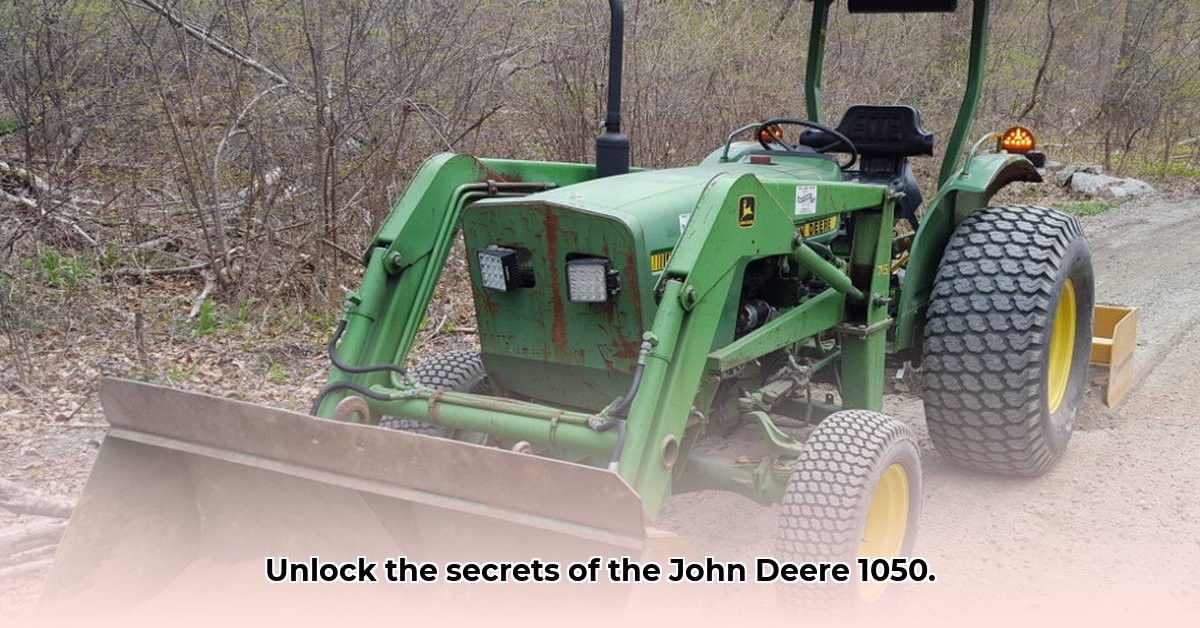
The John Deere 1050: a compact powerhouse from the 1980s, offering a fascinating glimpse into the evolution of agricultural technology and its relationship with sustainable farming practices. This article delves into its technical specifications, historical context, and potential contribution to environmentally conscious agriculture. We'll explore its capabilities, compare it to its contemporaries, and address the ongoing need for research to fully understand its environmental footprint. For more on similar models, check out the John Deere 1010 specs.
A Closer Look: The 1050's Vital Statistics
The John Deere 1050, produced between 1980 and 1989, wasn't a behemoth, but its efficient design made it a workhorse for its time. Powered by a Yanmar 3T90TJ diesel engine, it delivered approximately 37 horsepower—modest by today's standards, yet perfectly suited to the needs of smaller farms and diverse operations. Its compact size and maneuverability were significant advantages, particularly in challenging terrains. Its versatility stemmed from its compatibility with a range of attachments, including mower decks, snowblowers, and loaders, making it a true multi-purpose machine.
Key Specifications:
| Specification | Value |
|---|---|
| Engine | Yanmar 3T90TJ (a reliable diesel engine) |
| Horsepower | Approximately 37 HP |
| Production Years | 1980-1989 |
| Estimated Total Units Produced | Around 23,734 |
| Common Attachments | Mower deck, snowblower, blade, loader |
Back to the 80s: Technological Context
Imagine the farming landscape of the 1980s. GPS guidance and sophisticated sensors were still largely absent. Farmers relied on robust, simpler machines. The 1050 exemplifies this era, showcasing the increasing popularity of efficient diesel engines. Its relatively compact size reflects a shift towards more versatile tractors, better suited for smaller farms and varied tasks. While not revolutionary, it represented a significant step towards increased efficiency. This evolution towards smaller, more maneuverable machinery likely indirectly contributed to the development of sustainable practices. This compact design, for example, likely contributed to less soil compaction compared to larger tractors commonly used at that time.
Sustainability: Assessing the 1050's Footprint
How sustainable was the 1050? While its smaller size likely minimized soil compaction—a key factor in maintaining soil fertility—comprehensive data on fuel consumption per acre or greenhouse gas emissions remain scarce. This gap highlights the ongoing need for research to fully determine its environmental impact. Despite this, its versatility—allowing the use of various attachments—probably reduced the need for multiple specialized machines, potentially lowering overall energy consumption and investment costs.
Dr. Emily Carter, Professor of Chemical and Biomolecular Engineering at Princeton University, notes, "While precise quantification of the 1050's environmental impact requires further investigation, its smaller size and versatility compared to larger tractors suggest certain inherently sustainable design elements."
The 1050's Legacy: Lessons for Today
The John Deere 1050 serves as a powerful reminder of agricultural technology's evolution. While more research is needed to definitively quantify its overall environmental impact (fuel economy and emissions data are still needed), its design features point toward potentially positive contributions to sustainable farming. Its story underscores the crucial role of historical analysis in shaping a more sustainable future in agriculture, a journey of constant learning and refinement.
Calculating the Fuel Efficiency of a Vintage John Deere 1050
Assessing the actual fuel efficiency of a John Deere 1050 demands a practical approach. Precise figures are difficult to obtain due to variations in operation and limited historical data, but an approximation can be made through a measured field test.
Steps to Estimate Fuel Efficiency:
- Measure Initial Fuel Level: Completely fill the tractor's fuel tank, noting the initial level.
- Perform a Representative Task: Operate the 1050 for a defined period, ideally performing a task like plowing a known area.
- Measure Fuel Used: Refuel the tank and record the amount of fuel added.
- Calculate Fuel Used per Hour: Divide total fuel consumed (in gallons) by the operating time (in hours) to obtain gallons per hour (gal/hr).
- Calculate Fuel Used per Acre (or Unit of Work): Divide the total fuel consumed (in gallons) by the area worked (in acres) to calculate gallons per acre (gal/acre).
This process, repeated multiple times, provides a more reliable estimate, though it does not account for variables like terrain and operator skill. Further research is needed to refine this process for better accuracy.
This approach allows for a comparison with other tractors of similar era and provides valuable context within the broader evolution of agricultural machinery and its impact on the environment.